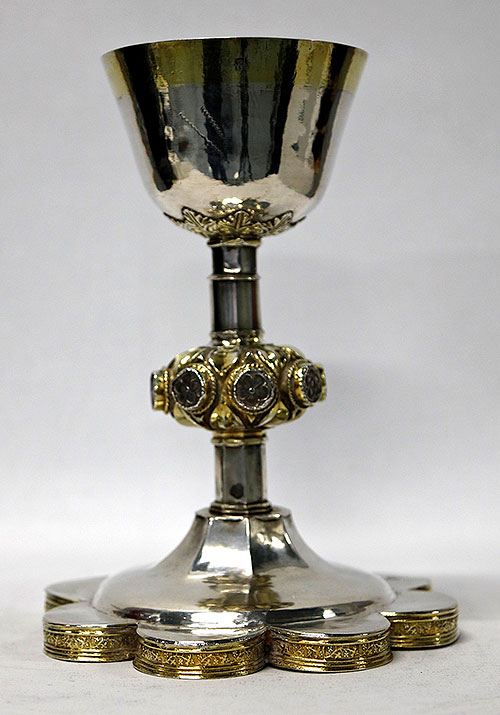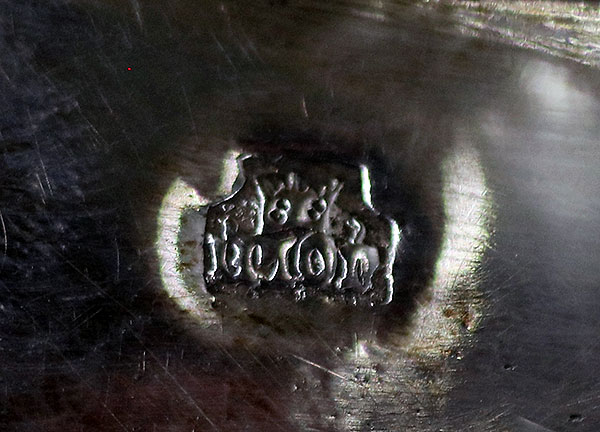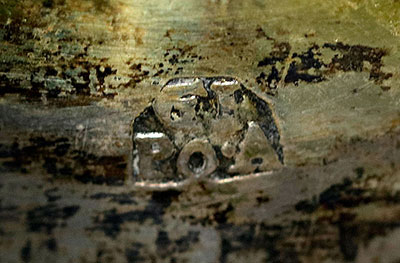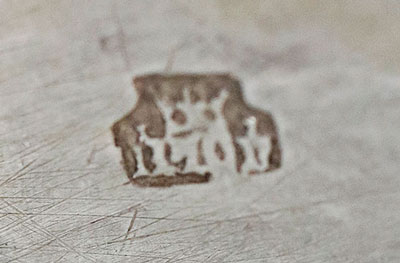The piece of the month of July 2023
TWO UNPUBLISHED GOTHIC CHALICES WITH MARK OF PAMPLONA IN PRIVATE COLLECTION
Ignacio Miguéliz Valcarlos
Chair of Navarrese Heritage and Art
University of Navarra
As in other peninsular centers, Navarrese silverware experienced a strong development during the 16th century, when the use of silver as a material for making sacred vessels and other pieces for divine worship became widespread, at the same time as the settlement of different typologies and the birth of new ones. This development will culminate in the last third of the century, when some of the most interesting works of this art in Navarre will be made. Likewise, in the previous century, the first laws and control rules for the work of silver in Navarre had been legislated, with the implementation of the marking system and the appearance of the San Eloy guild, which brought together, among others, the master silversmiths. This development of Navarrese silversmithing, which was parallel to that of other peninsular centers, made the 500s one of the most flourishing and original periods in the history of this art in Navarre, with the production of pieces of great artistic richness. Within this panorama, the evolution was gradual, from the first decades of the century to the last, observing in the first half of the century the survival of elements of Gothic tradition. This attachment to previous models was reflected above all in the typology of the chalice, where the evolution to the new Renaissance style was gradual, being introduced first in the ornamentation. In the case of this subject of pieces, in Navarre we can see the execution of several different models, each of which will also adopt particular variants. Within this context we must place two chalices that, coming from the art market, are conserved in a private collection in Barcelona. Both pieces are stamped with the locality of Pamplona, although only one of them has a mark of authorship. In spite of the stylistic differences between the two, both can be dated to the second third of the 16th century, following the prevailing models at that time in the center of Pamplona.

The first of these, made in silver in its color and gilded, has a base of profile truncated cone, with a base of hollowed out socle between straight moldings, followed by a carved body that gives way to the cylindrical shaft, with an apple knot with circular kissing alternating with thistle leaves, and a bell-shaped cup. As is usual in the center of Pamplona, this is a piece of great simplicity, where the architectural structure of the work prevails, presenting a sober decoration composed of a crenellated border that separates the upper part from the base of the shaft, and different vegetal elements: scrolls on the shaft, five-petaled flowers on the kissers and the thistle leaves of the apple, which is completed with the incised figure of a cross on rocks at the base.
|
|
|
As we have already said, it has stamped on the base the locality mark of Pamplona, PPLON, in Gothic characters and with a tilde on the first P and the final N, surmounted by a crown, as well as the silversmith's mark, GI/PO-A, corresponding to the artificer Pedro de Aróstegui (1502-1562). As Asunción de Orbe y Sivatte points out, this locality punch corresponds to the first variant of the mark used in the city, which began to be used in 1423, after the declaration of the Privilege of the Union of Pamplona by Charles III, and which lasted until 1574, when the royal order was promulgated by which Navarre began to use the metal law of Castile. The same author identifies the mark of authorship as that of the master Pedro de Aróstegui, a craftsman documented between 1533 and 1562, also the author of a cross for San Lorenzo de Pamplona, now lost, and of the cross of Alcoz, two pyxides of Marcaláin and one of Unzu, all of them, like the piece studied here, of great simplicity. This chalice corresponds to one of the chalice models employee in Pamplona, although it is not exclusive to this workshop, with a truncated cone base profile , when the most common is that they are polylobed, with an apple knotted shaft and an open cup, as is also the case with the chalice from Ciganda or one from the cathedral of Pamplona. However, in this work from a private collection, the decoration of circular kisses and thistle leaves located in the apple knot has a greater development than what we see in other examples, where vegetal elements are generally inscribed in cartouches of rhomboidal section that adapt to the profile of the apple knot.

The second of the chalices we are dealing with corresponds to another type of chalice made in Pamplona, although again not exclusively. It is a variant of the model most common in the Pamplona workshops, with a raised base articulated by eight lobes and a circular body, hexagonal shaft with an apple knot and an open cup with rose. The Burgui chalice corresponds to this model . However, the piece studied here introduces the novelty that the upper part of the circular body of the base is truncated truncated truncated pyramidal, and not truncated conical. Thus, it is a chalice made of silver in its color and gilded, articulated by means of a polylobed base with a raised plinth on which sits a second circular body and another, in continuity, octagonal, which gives way to the shaft, also octagonal. Flattened apple knot with alternating circular kissing with lanceolate leaves and bell-shaped cup with rose of vegetal motifs. It presents a structure of great simplicity, in which the architectural lines prevail, to which is superimposed a sober decoration that is articulated by means of a vegetal border between moldings in the base of the base, flowers of five petals in the kisses of the apple knot, outlined by means of a molding sogueda, and by the thistle leaves that form the rose.

It has the same locality mark of Pamplona, accompanied by the engraving, as the previous piece, PPLON in gothic characters and with a tilde in the first P and the N, surmounted by a crown, which corresponds to the first locality stamp of the capital of Navarre, employee, as we have said, between 1423 and 1574. Unlike the previous piece, it does not have a maker's mark, so we do not know the silversmith who made it. As already mentioned, stylistically it is a variant of the model of the Burgui chalice, model which lasted over time and of which numerous examples remain. Contrary to that of Burgui, where the kisses located in the apple knot are incised and of profile rhomboidal to adapt to the curvature of the apple, in the calyx studied here they are circular, of greater development, and alternate with lanceolate leaves. Similar to this are the chalices of Reta and Urdanoz, with a more developed rose and a border of cells at the base, or those of Góngora and Liédena, which do not have a rose. There were many silversmiths in the center of Pamplona who made works following these chalice models and several of them show the same variant of locality mark, although none of them has a close stylistic link that allows us to ascribe the piece studied here to a specific silversmith.
Likewise, the absence of any reference letter on the piece itself, such as a registration or a heraldic element, prevents us from knowing the place of origin of these works. The presence of this subject of silver pieces in the art market is something usual and recurrent since the 19th century. In relation to this, we must not forget that, throughout the 19th century, Spain, and therefore Navarre, suffered a series of wars, such as the Napoleonic and Carlist wars, which devastated the country, conflicts in which the silver of the churches was used to defray the considerable expenses incurred and that, in the same way, the treasures of many churches were plundered by the different warring sides and by bandits. To this must be added the effects of the ecclesiastical confiscations, which dealt a hard blow to the artistic treasures of a large issue of temples. All this led to the incorporation into the art market of numerous artistic pieces, including works of goldsmithing, which probably include the two chalices studied here.
SOURCES AND BIBLIOGRAPHY
HEREDIA MORENO, M.ª C. and ORBE SIVATTE, A., bibliography de los plateros navarros del siglo XVI. Aproximación a su entorno, Pamplona, Government of Navarra, 1998.
HEREDIA MORENO, M.ª C. and ORBE SIVATTE, M., Orfebrería de Navarra 2. Renaissance, Pamplona, Caja de Ahorros de Navarra, 1988.
MIGUÉLIZ VALCARLOS, I., "Pérdida de las alhajas de plata por la Iglesia navarra durante la Guerra de Independencia (1808-1814)", in Príncipe de Viana, n.º 256, Pamplona, Gobierno de Navarra, 2012.
ORBE SIVATTE, A., Platería del Reino de Navarra en el siglo del Renacimiento, Pamplona, Government of Navarra, 2000.
ORBE SIVATTE, A. and ORBE SIVATTE, M., "Aproximación al funcionamiento de los plateros de la ciudad de Pamplona", in Príncipe de Viana, n.º 192, Pamplona, Government of Navarra, 1991.


